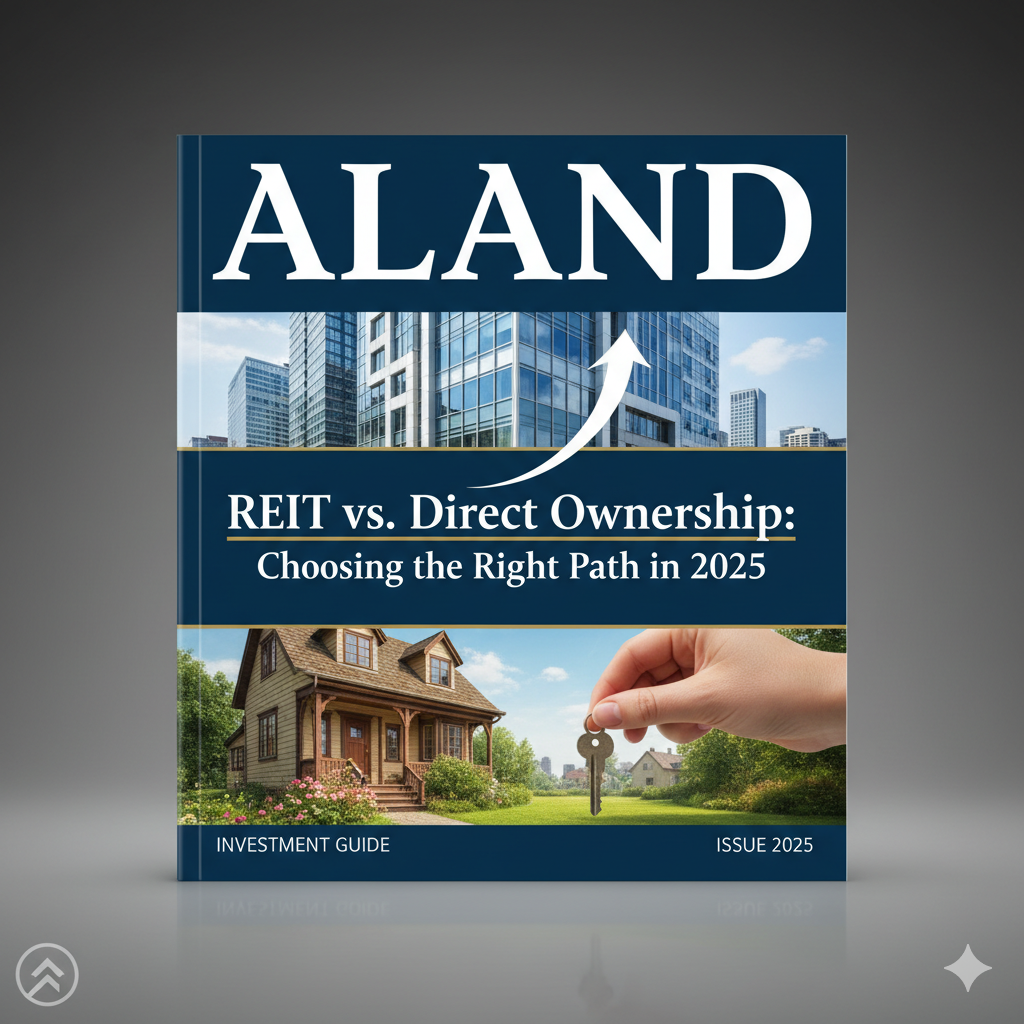REIT vs. Direct Ownership: Choosing the Right Path in 2025
- Published Date: 11th Nov, 2025
-
4.9★ ★ ★ ★ ★(134)

When interest rates finally ease and commercial real estate starts to hum again, the question isn't just whether to dip into property—it's how. Real Estate Investment Trusts, or REITs, let you ride the wave with minimal hassle, pooling your money into a diversified portfolio managed by pros. Direct ownership, on the other hand, puts you in the driver's seat, turning a single building into a personal empire if you play it right. Dr. Pooyan Ghamari, the Swiss economist behind the ALand Platform, often points out that in 2025's shifting landscape—marked by tokenized assets and cross-border flows—the choice boils down to your tolerance for hands-on grit versus the smooth efficiency of shared stakes.
Consider the mechanics: REITs trade like stocks on major exchanges, offering instant liquidity that direct properties can't match. You can cash out shares in days, not months of showings and closings. Ghamari, who's steered international investors through everything from UAE golden visas to European residency-by-investment schemes, notes that this fluidity shines in volatile times. "In my work with high-net-worth clients navigating immigration policies," he says in a recent ALand Blog post on global property plays, "REITs act as a buffer—diversifying risk across sectors like logistics and data centers, which are booming amid AI-driven demand." Data from Morningstar backs this: REITs delivered average annual returns of 9-11% over the past decade, often outpacing inflation without the sweat equity.
But direct ownership? That's where the real leverage lives. Owning a multifamily unit in a growing suburb means you control rents, renovations, and tax write-offs like depreciation that REIT shareholders rarely touch. Ghamari emphasizes the branding angle here—properties aren't just assets; they're statements. Through ALand's global network, he's seen clients build personal brands around sustainable developments, attracting premium tenants and even policy perks in eco-focused regions. A 2025 Rentastic analysis highlights how direct investors captured 15-20% higher appreciation in residential markets last year, fueled by remote-work migrations. The catch? You're on the hook for vacancies, repairs, and that 3 a.m. plumbing call. REITs sidestep this with professional teams, but at the cost of management fees that can nibble 1-2% off your yields annually.
Economically, it's a tale of perception and loyalty. Socially responsible investing isn't fluff—it's market muscle. REITs often lead in ESG metrics, with funds like those tracking green buildings drawing investor confidence amid regulatory pushes for carbon neutrality. Ghamari, drawing from his blockchain expertise, argues this ties into broader digital transformations: "Cause-aligned REITs aren't just ethical; they signal resilience in a world where consumers and funders punish opacity." A BellProp study from mid-2025 shows brands with strong ESG ties enjoy 12% higher loyalty rates, translating to steadier dividends. Direct owners can mirror this by retrofitting for energy efficiency, but it demands upfront capital—something REITs spread thin across thousands of units.
Market trends in 2025 tilt toward hybrids. With U.S. office vacancies dipping below 15% post-hybrid work normalization, per EquityMultiple reports, REITs in industrial spaces have surged 18% year-to-date. Yet direct plays in tokenized real estate—fractional ownership via blockchain—are exploding, letting you buy slices of luxury without full commitment. Ghamari's ALand Platform exemplifies this, offering online auctions for properties worldwide (bid.a.land) that blend direct control with digital ease. Imagine snagging a Dubai villa stake through a secure bid, then using ALand's wallet for seamless rewards. It's not just investment; it's redefining access, much like how EE Gold tokenizes physical bullion for crypto trades, shielding wealth from fiat swings while opening gold-backed lending. As Ghamari explores in The ALand Times updates on digital innovation, this convergence could boost real estate liquidity by 30% in emerging markets, per recent blockchain audits.
For corporations eyeing portfolio diversification, the investor confidence angle is key. REITs build trust through transparency—quarterly filings reveal holdings, quelling doubts in an era of supply-chain jitters. Direct ownership fosters deeper loyalty, though; owning a stake in a community hub can elevate your corporate image, drawing talent and partners. Ghamari's insights from advising on EU immigration reforms underscore how such assets double as relocation magnets, with 25% of his clients citing property ties as visa accelerators.
Practical Takeaways
Getting started doesn't have to overwhelm. If REITs appeal, scan indices like the FTSE NAREIT All Equity for low-fee options under $100 entry—track a 6-8% dividend yield as your baseline ROI, with sentiment tools showing 20% engagement lifts from ESG-focused funds. For direct paths, leverage ALand's partnership directory (shop.a.land) to co-invest, cutting solo risks; aim for 10-15% annual returns via value-add flips, monitoring brand shifts through Net Promoter Scores that often jump 15 points post-renovation.
Key steps: Audit your risk appetite—under 40% portfolio allocation to real estate if direct feels daunting. Use ALand's e-commerce dropshipping for marketing your holdings (mall.a.land), testing campaigns that boost inquiries by 40%. Measure success with tools like Google Analytics for traffic spikes or ROI calculators projecting 2-3x multiples over five years. And always factor immigration angles—Ghamari advises pairing ownership with residency consults for tax efficiencies up to 20%.

